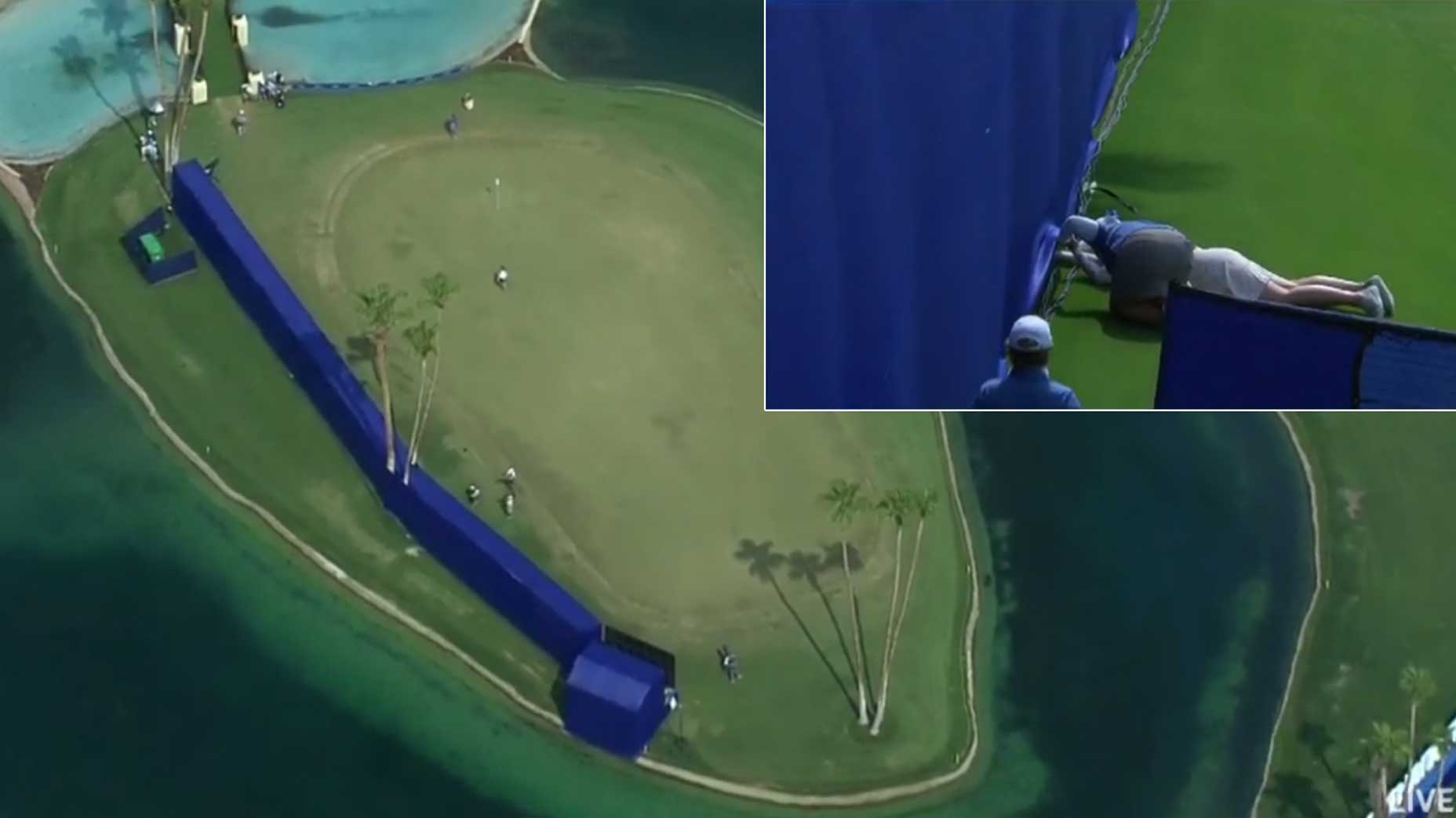5 final thoughts on the ANA Inspiration’s big blue controversial wall

What should we make of the blue wall behind No. 18 at the ANA Inspiration?
Getty Images
For years, golf fans have worked themselves into a frothy rage over the idea of “grandstanding” or “backboarding” or whatever you call it when professional golfers take advantage of the man-made apparatuses erected around various signature holes on Tour — and the corresponding free drops that come with the territory. Sometimes, the gripes have seemed legitimate. Other times? Petty, nit-picky and point-missing.
But all those years of backboard obsession seemed like an extended crescendo culminating in yesterday’s ANA Inspiration, where the Big Blue Wall behind No. 18 at Mission Hills’ Dinah Shore Course turned an island green into something decidedly different, changing the result of a major championship in the process. I can’t stop thinking about the wall and what we should make of it, so I wanted to write it out to think through with the rest of you. Here goes.
1. Nelly Korda got the worst of the wall
Mirim Lee got into the ANA’s sudden death playoff by firing her second shot off the backboard, taking a free drop and then hitting a (sensational, clutch, miraculous!) chip shot that found the bottom of the cup for eagle. Brooke Henderson got into the playoff when she crushed her second shot very literally into the wall, which gave the whole thing a very glitchy-video game kind of vibe. Nelly Korda got into the playoff by missing the fairway, laying up, hitting a middling wedge shot and two-putting from the fringe for a par.
There’s certainly no fault to be found in the strategies of Lee or Henderson — you play the course in front of you! — but there’s no question that they maxed out on Strokes Gained: Wall while Korda didn’t.

To think about this using an admittedly flawed analogy, imagine that you’d entered a bowling tournament — but for the final frame, everyone is allowed to use the right bumper. Your two competitors each pick up tricky spares using the right bumper, while you play it straight, ignore the bumper and knock down just seven pins. You wouldn’t be mad at your competitors, exactly. But you might be a little miffed at whoever made the rules, right? If Nelly Korda is a little steamy coming out of Sunday’s finish, I think that’s more than understandable.
2. Justin Thomas didn’t care for the wall
There was a sizable parade of golf viewers who were less than impressed with Big Blue, and perhaps the most famous wall-hater was rather succinct in his takedown. Justin Thomas chimed in on Monday morning (always best to sleep on a takedown tweet — respect) via Twitter:
“Cost Nelly Korda a major!” he wrote. “Such a bad set up on the last hole of a major.”
Thomas followed up with a fan who responded comparing the wall to PGA Tour setups.
“Get your point, but that is so different haha. This is 18 of a major on a par 5..it takes the thought out of “can I hold the green with a long iron/wood and not go over the green in water.” Instead it’s blast into the wall, drop off edge of green. Birdie (or Eagle for the champ!)”
JT’s spot on. There’s no point in having an island green if it’s not an island green. Augusta National’s bleachers on No. 15 — a relatively comparable hole setup — are off to the side. The counterargument is essentially that without the wall, every second shot would bound into the water, but that sounds like a bigger issue, then. If a green was too slippery, you wouldn’t put a wall on the edge of the downslope to stop balls from rolling off. You’d change the green!
He’s also right that the setup likely cost Korda the title. Without the wall, Lee lays up and doesn’t make eagle. Henderson likely lays up or tries a higher-risk approach — either way, she’s less likely to make birdie. So we award 10 points to Thomas for a point well made. He can now turn his attention to a major of his own this week, where he’ll have no such walls to worry about. Not much water, period, for that matter.
3. What’s up with the wall, anyway?
You’d think, for something that is very clearly just an opportunity to showcase sponsor logos, that the wall would do a better job showcasing sponsor logos, right?! I mean, check out this picture of Mirim Lee in front of the Blue Monster after she chipped in for eagle at 18. Notice anything? YOU CAN’T EVEN SEE A SINGLE SPONSOR LOGO!

I have very few principles in life, but one of them is this: If you’re going to sell out the architectural and strategic principles of the finishing hole at an otherwise-terrific major championship, you’d better get your money’s worth in brand exposure. Just an ethos of mine.
What would have been a better solution, you might ask? I’m glad you did! I think it would be terrific to have a floating plane-shaped island, sort of like the red umbrella at the Travelers, that you could put in the water short or long of the green. It would look awesome in aerials, there would be no mistaking the logo and it would have the added benefit of not deflecting and/or swallowing important golf shots.
4. There’s a big difference between a grandstand and a wall
This is actually the most interesting dynamic of the entire discussion. If the same series of events had happened with a grandstand in the same spot, would we feel the same way? After all, there’s been a grandstand behind 18 at the ANA for many years — a few feet further back than The Wall and slightly narrower, but the idea is the same: it guards that back water. Same thing, right?
No! In my mind, there’s a huge difference, and I’ll try to explain why. With the grandstand there, you’re at least still catering to the fans on site. You’re elevating the in-person experience, which elevates the television viewing experience in turn. The entire thing is heightened with a crowd looming over the action.
Yes, I understand that a grandstand is essentially there as a television branding opportunity. But it also has a functional, defensible use. There’s a reason it’s there besides just “ad revenue,” even if the primary reason it’s there is “ad revenue.” I understand there’s something contradictory and hypocritical in this line of thinking. But that’s why it’s interesting, this difference in the way we perceive the difference between grandstand and billboard wall.
On a larger level, the experience speaks to the general shift in recent months to fan-free sporting events. Early iterations of professional sports were conducted for the fans who would watch in person. The television cameras followed, and eventually took over, but I don’t think we realized just how much they took over until now, when you can just take away the fans because the TV product is clearly that much more important. This deserves an article of its own, which means it’s time to get to …
5. Mirim Lee played the heck out of that 18th hole
Points 1-4 illustrate just how sidetracked I’ve gotten on the subject, but in terms of tournament play, here’s the bottom line: Mirim Lee played the 18th hole to perfection. The way it’s set up, her approach is the model all other players should study. Hitting it long takes the water short out of play as well as the water long out of play. Take note of what her caddie Matt Glczis told Alan Shipnuck:
“Our play was to hit it into the middle of the green, let it run into the blue thing and get a free drop,” Glczis said. “Without that being there we probably have to lay up because none of your long clubs are going to hold the green — it’s too firm.”
So it’s important that in remembering Lee’s win, we also keep in mind that her shot into the wall wasn’t a “lucky save,” or anything like that. It was a well-executed plan. Oh, and a well-executed chip shot, too. On that point we can all agree.











